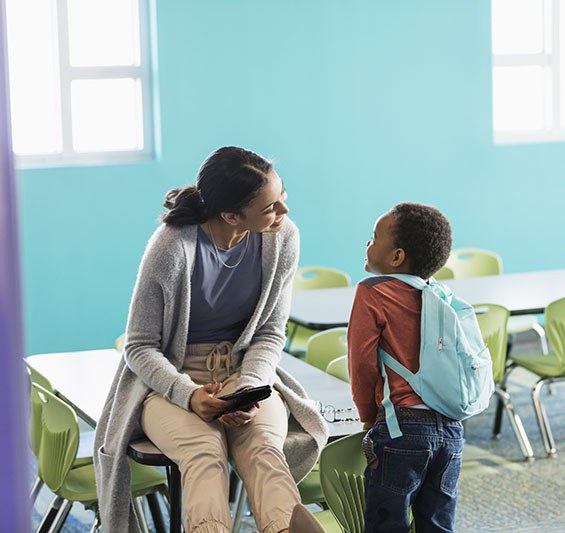Posted: August 5, 2019
What comes to mind when you think of school readiness? Many would say that school readiness includes a child’s ability to get along with others, and to recognize some numbers and some letters of the alphabet. These skills are important, but school readiness also includes the many skills that develop over time from a child’s birth through school entrance age.

School readiness includes the areas of social-emotional, cognitive, language and literacy, and physical development. Another important dimension of school readiness, approaches to learning, includes a child's ability to maintain focus on a task and show interest and curiosity in learning.
Each of these important areas is influenced by a child's experiences with others and his unique makeup. The interactions children have with caring adults inside and outside of their families, and each child's developmental history and unique makeup, all influence the development of school readiness skills.
School readiness: How to support children's development
Social and emotional development includes
- Developing self-regulation skills or self-control.
- Building problem-solving skills.
- Forming relationships with others.
- Identifying feelings in yourself and others.
Why it matters:
Building social-emotional skills is the foundation for all development. When children develop strong social-emotional skills, they are better able to form and maintain friendships and better able to focus attention on learning.
How to support development:
- Notice and talk with children to support building positive relationships.
- Help children make connections with one another to support developing friendships.
- Talk about feelings and identify feelings throughout the day.
- Model and support ways to help children calm down, identify a problem and talk about how to solve the problem calmly.
Cognitive development includes
- Building thinking skills.
- Building reasoning skills.
- Building problem-solving skills.
- Building memory skills.
Why it matters:
Building thinking, reasoning, problem-solving and memory skills forms a foundation for all learning.
How to support development:
- Play games with children that support memory: matching pictures, letters, or number cards.
- Provide games and materials that require children to problem solve in a variety of ways: counting to figure out how many blocks may fit in the back of a toy truck, arranging items in a pattern during a game, or grouping items by shape, color, or size.
- When children are playing, building, and creating, ask children questions about why they think something happened, or what they think might happen.
- Allow time for discovery activities (science experiments, cooking activities). Talk with children about their predictions. For example, before mixing cornstarch and water, ask children what they think will happen when the ingredients are mixed.
Language and literacy development includes
- Building vocabulary skills.
- Building comprehension skills.
- Building phonological skills (the ability to manipulate sounds in spoken language). For example, identifying spoken rhymes and generating rhymes, or being able to put together or take apart sounds in spoken words.
- Building letter and letter-sound knowledge.
Why it matters:
Building strong language and literacy skills supports growth in cognitive and social emotional development, and is related to later school success.
How to support development:
- Read to children every day and have conversations with children about books, asking questions about what might happen next in the story, how the characters are feeling, and how something might relate to a child's own experience.
- Have conversations with children throughout the day, for example, at mealtimes, playtimes, and during routine times. Any time of day is a great time to talk with children!
- Play games that support letter identification, like "I spy a letter" or letter matching games. Provide alphabet puzzles, and card games that support letter knowledge. Point out letters in everyday life throughout the day. Offer children writing materials and support to explore writing throughout the day.
- Read rhyming poems and stories, sing rhyming songs, and play rhyming games. For example, "I'm thinking of a word that rhymes with cat and begins with a "b" sound. What do you think it could be?"
Physical development includes
- Building large motor skills.
- Building fine motor skills.
Why it matters:
Building large motor skills is important for physical growth and development. Building fine motor skills is important for successful completion of small motor tasks.
How to support development:
- Allow children time for large motor activities. Provide toys and equipment that support large motor development like bikes, balls, and swings.
- Provide opportunities for individual and group games.
- Play games with children that promote running, skipping, jumping, and crawling.
- Provide opportunities and materials for fine motor skill development like cutting with scissors, painting, gluing, building, writing, stringing beads, tracing, and doing puzzles.
Share a PDF of this article or download it for yourself!
References
- National Scientific Council on the Developing Child. 2004. "Children's Emotional Development Is Built into the Architecture of Their Brains: Working Paper No. 2."
- Nix, Robert L., Karen L. Bierman, Celene E. Domitrovich, and Sukhdeep Gill. 2013. "Promoting children's social-emotional skills in preschool can enhance academic and behavioral functioning in kindergarten: Findings from Head Start REDI." Early Education & Development 24(7): 1000-1019.
- McCardle, Peggy, Hollis S. Scarborough, and Hugh W. Catts. 2001. "Predicting, Explaining, and Preventing Children's Reading Difficulties." Learning Disabilities Research and Practice 16(4): 230-239.
- Maxwell, Kelly, Tamara Halle, and Nicole Forry. 2013. "Five things to know about school readiness." Child Trends 5. Publication #2013-35.
- Daily, Sarah, Mary Burkhauser, and Tamara Halle. 2010. "A Review of School Readiness Practices in the States: Early Learning Guidelines and Assessments." Early Childhood Highlights. Child Trends 1(3).

